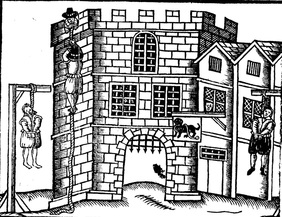Seventeenth-Century England
Disorder. Order regained.

Woodcut depicting executions at Newgate Prison
Historians from Christopher Hill onwards have called mid-seventeenth century England a 'world turned upside down.' Religious and political upheaval, civil strife and warfare, along with class and gender conflicts made this era a volatile time--an era when society craved order. A strong legal tradition permeated English society, in both civic and ecclesiastic settings, as did a 'bottom-up' tradition of community monitoring and control. But there was nothing like the police force that emerged in the eighteenth century, nor was the jury and trial system exactly the same.
The 1660s represented an attempt to regain order, with the restoration of the Stuart line King Charles II (son of Prince Charles, beheaded at the order of Cromwell's Parliament). Yet, under Charles, theaters were reopened, Puritan stringency was cast aside, and a general frenzied air permeated the first few years of his reign.
Between 1664 and 1666, two great disasters befell England--London most catastrophically. First, the plague struck heavily, killing thousands and thousands of people. Then, before anyone could even recover, the Great Fire of London swept through much of the city, destroying nearly 13000 homes and rendering thousands homeless (explained more here). The struggle for order was formidable.
Consequently, a remarkable social mobility occurred among the survivors, as servants and apprentices took over their master's homes and livelihoods. While the fire courts sought to deal with these impostors and usurpers, identity and property theft were widespread.
So you can see why this time period is so frakkin' awesome...
The 1660s represented an attempt to regain order, with the restoration of the Stuart line King Charles II (son of Prince Charles, beheaded at the order of Cromwell's Parliament). Yet, under Charles, theaters were reopened, Puritan stringency was cast aside, and a general frenzied air permeated the first few years of his reign.
Between 1664 and 1666, two great disasters befell England--London most catastrophically. First, the plague struck heavily, killing thousands and thousands of people. Then, before anyone could even recover, the Great Fire of London swept through much of the city, destroying nearly 13000 homes and rendering thousands homeless (explained more here). The struggle for order was formidable.
Consequently, a remarkable social mobility occurred among the survivors, as servants and apprentices took over their master's homes and livelihoods. While the fire courts sought to deal with these impostors and usurpers, identity and property theft were widespread.
So you can see why this time period is so frakkin' awesome...